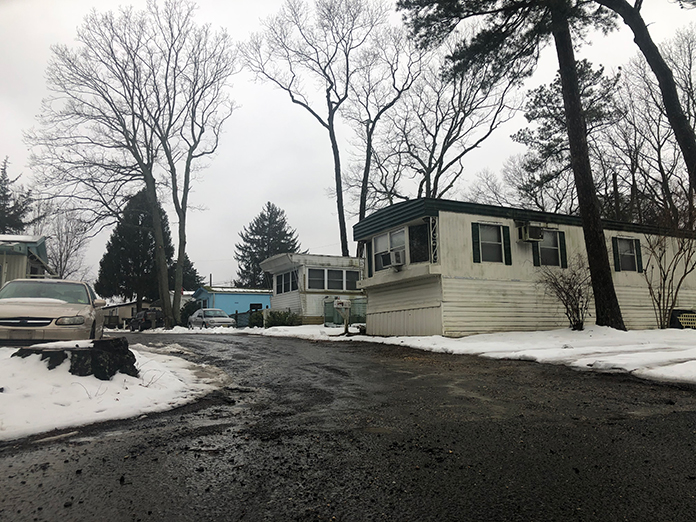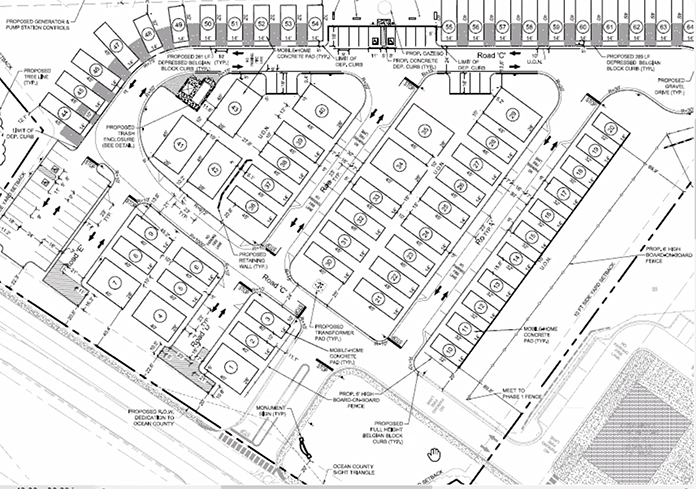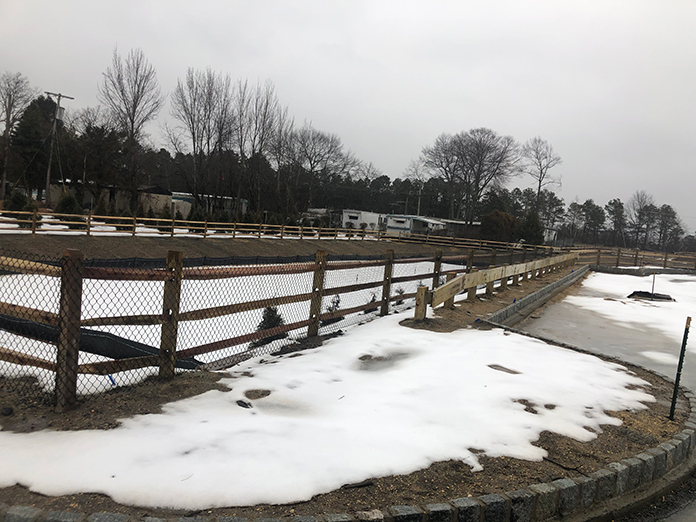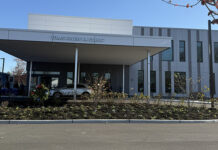
BRICK – At one time, there were over 100 residences at the Laurelton Mobile Home Park, located on a 12-acre site at the intersection of Route 88 and Jack Martin Boulevard, but only 34 trailers remain as residents have either moved or died.
The front of the site is currently undergoing redevelopment, with the construction of a Wawa convenience store and gas station, retail pad and bank well underway, while the remaining trailers have been relocated to the back of the property.
It was understood that the mobile home park was being phased out, but that’s not the case since the developer now plans to spend “multiples of seven figures” to redevelop the mobile home park that would have 66 new pads for mobile homes and would include new utilities, paving, landscaping and fire department access, said the applicant’s attorney Doug Wolfson during a February 3 Board of Adjustment meeting.

The developer, JSM (Jack and Sheryl Morris) is well-known in Brick since they built the Costco shopping center and will be developing a retail complex in part of the former Foodtown site.
Their company, Edgewood Properties, needed to obtain both a Use Variance and a Subdivision Variance before they could relocate the new mobile home park behind the commercial development.
Township Planner Tara Paxton said as with any land use, applicants “can change their mind and ask for something else.” Mobile home parks are allowed in the township under certain circumstances, which includes the pre-existing Laurelton Mobile Home Park, but JSM needed a Use Variance because they are altering the site and increasing the number of units, she explained.
The mobile home development will be age-restricted. Each individual occupant would own their own trailer – which are technically vehicles registered with the DMV – and would rent one of the 66 pads being built by JSM, Paxton said.
15 percent of any new multi-family home development must count towards the township’s affordable housing obligation, by ordinance, she explained. Since there are already 34 tenants in the existing mobile homes, five of the 32 new units would be deed restricted for 30 years for low- to moderate-income residents.
“At the end of the day, no matter how you look at this, we are essentially taking what is predominantly a dilapidated, outmoded, un-anesthetic mobile home park and…making it something that is worthy of the JSM portfolio,” Wolfson said during the Board of Adjustment meeting.

He said there would be 11.66 pads for mobile homes per acre, up from 10.77 an acre previously.
The meeting was a continuation of an October 21, 2020 Board of Adjustment meeting when Paxton and Board Engineer Brian Boccanfuso raised some concerns and issues about the applications at the end of the meeting.
Since then, JSM revised the plans for the mobile home park that reflect the concerns raised, said JSM’s Director of Engineering Ron Aulenbach.
One of the concerns was that car headlights would shine onto some of the mobile homes as they entered the parking lot from Jack Martin Blvd. Revised plans show an added buffer created by the construction of a berm, fencing and landscaping.
The township was also looking for some recreational components for the site, Aulenbach said. Revised plans include an area with picnic tables and a gazebo.
“One of the major factors that came out of our conversation with the township and Board was a concern about what happens between the trailers?” he said.
For example, if two adjacent trailers have front door stairs facing each other, it ruins the ability to have access around the trailer, so the developer has agreed to make sure entrances don’t face each other and to have a minimum of five feet between steps and an adjoining trailer, Aulenbach said.
Boccanfuso had concerns about how sheds, patios, awnings and other accessory improvements would affect the site.
“There has to be some type of limitation to prevent all the open space that’s between these trailers to prevent unchecked impervious coverage within the site,” he said.
Impervious coverage is any man-made material, like homes or driveways, that prevent rain from soaking into the ground.
“There would need to be some type of agreement to how these things are going to be controlled, and the stormwater analysis would need to be checked to make sure it’s consistent with whatever those limitations are,” Boccanfuso said.

The applicant’s Planner Christine Cofone said 65 percent impervious coverage is allowed, and plans call for impervious coverage of about 48 percent.
Aulenbach said that the individual homes have to abide by township building codes. The lease provides that an onsite manager would ensure that homeowners can’t be a nuisance and would make sure there are no health or safety issues, Wolfson added.
Boccanfuso said the buffer between the proposed mobile home development and the previously approved commercial development did not comply with ordinance requirements.
Original plans called for a single row of large evergreen trees and two rows of shrubs, he said. The requirement calls for a triple-staggered row of evergreens spaced 10 feet apart, and at least 60 feet wide.
The applicant adjusted the footprint of a detention basin, and improved the buffer by adding the triple row of evergreens, but they still don’t have the width requirement, he said.
There are 100 parking spaces on site which breaks down to one and a half parking spaces per unit for the mobile home community.
There was no public comment on the applications, which Board members passed in a vote of 5-2.
All voted in favor except for Board of Adjustment Chairman David Chadwick and Michelle Strassheim, who voted against both applications.






